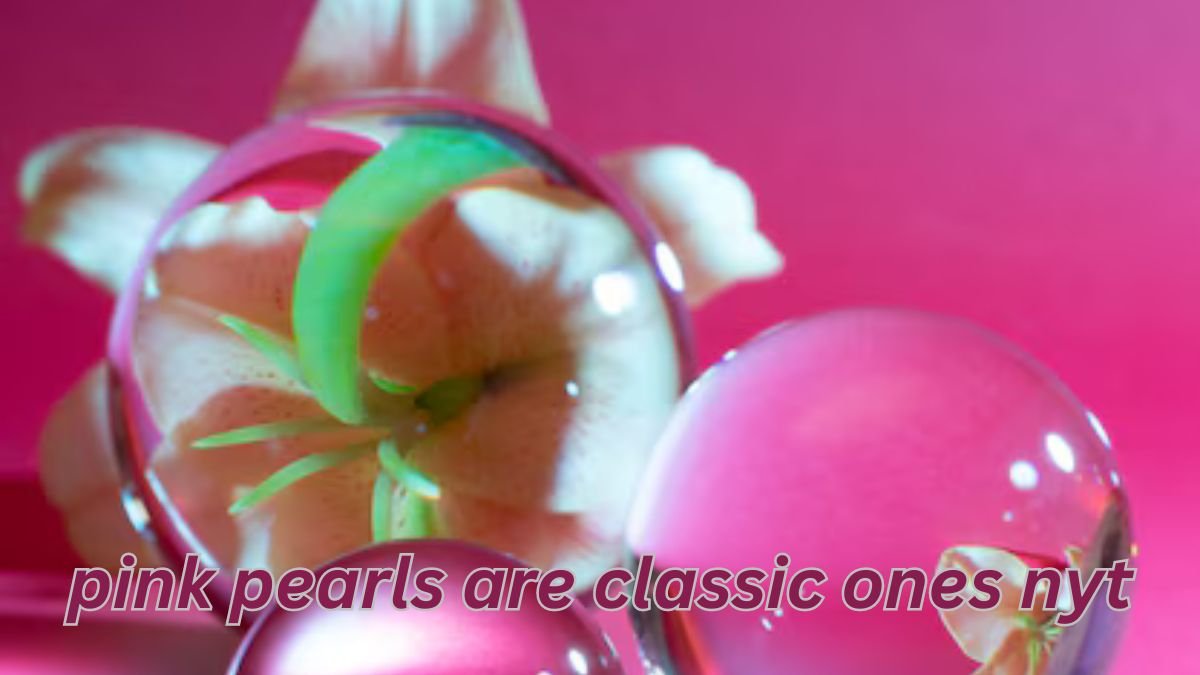Pink pearls have long been associated with classic elegance and sophistication. Ancient royals and modern-day fashion icons alike have graced their necks, wrists, and ears with these lustrous gems. Pink Pearls Are Classic Ones Nyt With their radiant and soft, feminine colors in combination with the uniqueness that creates a special sensation of exquisiteness pink pearls. Till today are enchanting more fans around the world. But why are pink pearls so coveted? What makes them jewelry classics?
The Allure of Pink Pearls: A Timeless Classic
Pink pearls are celebrated for their delicate hue, which ranges from pale blush to deep rose. Unlike the common white or cream pearls, pink pearls are relatively rare and are often associated with romance, purity, and luxury. The pink color can vary depending on the type of mollusk, the environment where the pearl was formed, and even the age of the pearl itself. This variance in color contributes to their unique charm and makes them highly sought after by collectors and jewelry lovers.
The Origins of Pink Pearls: A Natural Wonder
Pink pearls are produced by certain types of mollusks, particularly the Pinctada fucata, also known as the Akoya oyster, and the Pinctada margaritifera, commonly referred to as the black-lipped oyster. These oysters are primarily found in the warm waters of the South Pacific, around Australia, the Philippines, and Indonesia. The pink hue of these pearls is attributed to the specific conditions of the water, including its temperature, salinity, and the type of food available to the mollusk.
Natural pink pearls are extremely rare, accounting for only a small percentage of the pearls found globally. Most of the pink pearls available in the market today are cultured, which means they are grown under controlled conditions by implanting a small bead or tissue inside an oyster. Despite being cultured, these pearls retain the unique beauty and qualities of their natural counterparts.
A Glimpse into History: Pink Pearls through the Ages
Historically, pink pearls have been regarded as precious gems, symbolizing wealth, status, and power. They have been worn by royalty and the elite for centuries. The Roman Empire, for instance, held pink pearls in high esteem, with many noblewomen wearing them as a sign of their affluence. Pearls were so valued in ancient Rome that Julius Caesar once passed a law limiting the wearing of pearls to the ruling class.
During the Renaissance, pink pearls continued to symbolize opulence. They were often featured in portraits of European aristocrats, who adorned themselves with strands of these exquisite gems. In the 19th and early 20th centuries, pearls—especially pink pearls—became the ultimate symbol of elegance and refinement. Renowned figures like Coco Chanel and Grace Kelly popularized pearls, incorporating them into their everyday fashion statements, thus solidifying their status as timeless classics.
The Unique Beauty of Pink Pearls: What Sets Them Apart?
While all pearls have their unique charm, pink pearls stand out due to their distinct coloration and luster. The soft pink tones are particularly flattering against the skin, complementing various skin tones and adding a subtle glow. Pink pearls are also known for their orientation—a unique iridescence that makes them appear to change colors when viewed from different angles. This captivating play of colors is a result of the pearl’s layers of nacre, which are thinner and more numerous in pink pearls compared to other types.
The Different Types of Pink Pearls
- Akoya Pink Pearls: These pearls are produced by the Akoya oyster, primarily found in Japan and China. Akoya pink pearls are known for their high luster and smooth surface, often exhibiting a beautiful blush to rose overtone.
- Freshwater Pink Pearls: Cultured in freshwater mussels, these pearls are mainly produced in China. Freshwater pink pearls tend to be more affordable and come in a variety of shapes and sizes, making them versatile for different jewelry designs.
- Conch Pink Pearls: One of the rarest types, Conch pearls are not true pearls in the traditional sense. They are produced by the Queen Conch mollusk found in the Caribbean Sea and are known for their flame-like pattern. Their rarity and unique appearance make them highly coveted among collectors.
- South Sea Pink Pearls: These pearls are produced by the gold-lipped or black-lipped oysters found in the waters around Australia, Indonesia, and the Philippines. South Sea pink pearls are larger and known for their luxurious sheen and satin-like surface.
The Value of Pink Pearls: Investment or Accessory?
Pink pearls are often seen as a valuable investment due to their rarity and unique beauty. The value of pink pearls can vary greatly depending on several factors, including size, shape, luster, and depth of color. Generally, the deeper and more vibrant the pink hue, the more valuable the pearl.
The price of pink pearls can also be influenced by their type. For example, natural pink pearls are considerably more expensive than cultured ones. Conch pink pearls, due to their rarity and distinctive patterns, are among the most valuable on the market, often fetching thousands of dollars per carat.
How to Choose the Perfect Pink Pearl Jewelry?
When choosing pink pearl jewelry, it’s important to consider a few key factors:
- Luster: Look for pearls with a bright, mirror-like reflection on their surface. This is a good indicator of a high-quality pearl.
- Color: Pink pearls come in a range of hues from pale blush to deep rose. Choose a color that complements your skin tone and personal style.
- Shape: While perfectly round pearls are often considered the most valuable, other shapes such as oval, teardrop, or baroque can be equally beautiful and unique.
- Size: Larger pearls tend to be more valuable. However, the size should also suit your personal preference and the type of jewelry you’re purchasing.
Caring for Your Pink Pearls: Tips for Longevity
To maintain their beauty, pink pearls require special care:
- Avoid Exposure to Chemicals: Pink pearls are sensitive to chemicals found in perfumes, hairsprays, and household cleaners. Always put on your pearls last when dressing up.
- Clean Gently: Use a soft, damp cloth to clean your pearls after wearing them. Avoid using harsh chemicals or abrasive materials that could damage the nacre.
- Store Properly: Store your pearls in a soft cloth or pouch, away from other jewelry that might scratch them. Pearls need moisture, so avoid storing them in airtight containers.
Why Are Pink Pearls Trending Again?
Pink pearls have made a significant comeback in recent years, thanks to their timeless elegance and unique beauty. Modern fashion designers are incorporating pink pearls into their collections, highlighting their versatility and appeal across different styles and occasions. From minimalist pearl stud earrings to elaborate multi-strand necklaces, pink pearls offer endless styling possibilities.
Furthermore, sustainability trends in the jewelry industry have also contributed to the renewed interest in pearls, including pink pearls. Unlike diamonds or other gemstones that require mining, pearls are considered a more sustainable and eco-friendly option. Cultured pearl farming, when done responsibly, can even help to improve marine environments by encouraging cleaner water and promoting healthy ecosystems.
How to Spot Genuine Pink Pearls?
With the increasing popularity of pink pearls, the market has seen an influx of imitations. To ensure you’re purchasing genuine pearls:
- Feel the Weight: Real pearls feel heavier than imitation ones.
- Inspect the Surface: Genuine pearls will have slight imperfections and a gritty texture when rubbed against your teeth, while fake pearls will feel smooth.
- Check for Iridescence: Authentic pink pearls exhibit a unique play of color that changes with the angle of light.
Pink Pearls in Modern Jewelry Trends
Today, pink pearls are embraced in both traditional and contemporary designs. They are featured in everything from classic pearl strands to modern, avant-garde jewelry pieces. Celebrities and influencers have also been spotted wearing pink pearl jewelry, adding to its growing popularity among younger generations.
Conclusion: Pink Pearls – A Gem Worth Celebrating
Pink pearls are much more than just a piece of jewelry; they are a testament to nature’s artistry and the wearer’s refined taste. With their soft hues, shimmering surfaces, and timeless appeal, pink pearls continue to be a classic choice for those who appreciate elegance and sophistication. Whether you’re investing in a rare conch pearl or opting for a beautiful Akoya pearl necklace, pink pearls are sure to add a touch of magic to any collection.
Read More: Inside the World of Here Reigns The Vengeful Villainess Spoiler
FAQs
What makes pink pearls unique?
Pink pearls are unique due to their distinct hue, which ranges from soft blush to deep rose. Their color and luster are influenced by the type of mollusk, water conditions, and other environmental factors.
Are pink pearls rare?
Yes, natural pink pearls are rare. Most pink pearls available in the market are cultured, but even cultured pink pearls are valued for their unique beauty.
How do I care for pink pearls?
To care for pink pearls, avoid exposing them to chemicals, clean them gently with a soft cloth, and store them properly away from other jewelry.
What types of pink pearls are available?
Pink pearls come in various types, including Akoya, freshwater, South Sea, and Conch pearls, each with distinct characteristics and values.
Are pink pearls a good investment?
Yes, pink pearls can be a valuable investment due to their rarity and demand. However, the value depends on several factors, including size, luster, and color.
How can I tell if a pink pearl is genuine?
Genuine pink pearls are heavier than imitation ones, have slight imperfections, and exhibit a unique iridescence when viewed from different angles.





